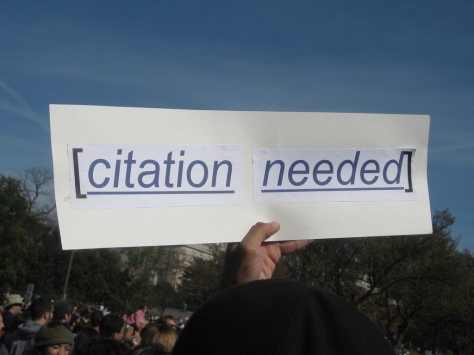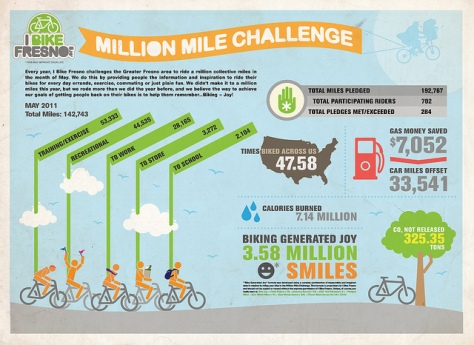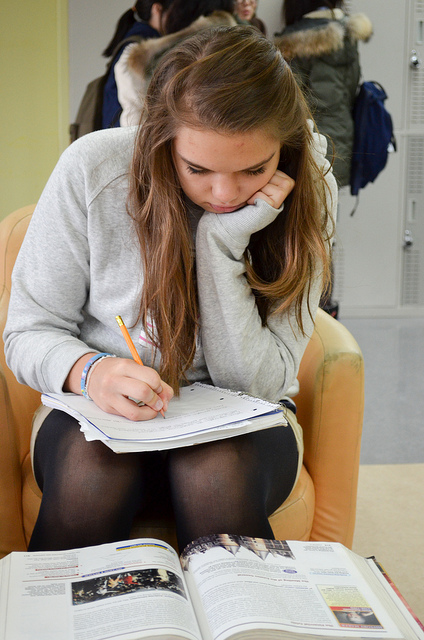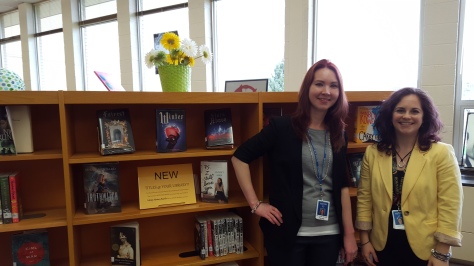
Sarah Strouse and Natasha Lewis are both new to Nazareth High School Library, both bringing a youthful energy and actively infusing exciting learning experiences through contests and collaborations and their new Makerspace. As I saw their Twitter posts stream through during the school year, I could only smile, knowing that my own children and their friends would soon be students served by their library media center. Through this interview, they inspired me (I do not have a Makerspace, yet…. :). They made me feel like a Makerspace was both manageable and worthwhile (I watch that with fads …making sure that I want to buy in …and I do with this one!), and they also provided me with some nostalgia (as I remembered the days when I, too, first discovered Dr. Joyce Valenza’s expertise and was incredibly inspired).
The following is our interview, conducted about their Makerspace:
- Can you describe your Makerspace?
- SS: Right now, our Makerspace is in its infancy and is located in a “slice” of our Library Media Center. It’s a place where students typically huddle in small groups and tinker. My vision for our Makerspace was highly influenced by Joyce Valenza’s blog article, “Library as a Domestic Metaphor.” Rather than act as a “grocery store” where students come, take, and leave, the library is more of a kitchen “where everyone lives and plays and laughs and makes a mess and creates and shares delicious stuff.” I think this is the type of environment we’ve begun to foster and hopefully continue to grow. It’s a place where students can tinker, make, and learn without the confines and pressures of the traditional classroom setting.
- What tools did you select to start your Makerspace with and why?
- SS: We started with very low-tech, low-cost stations like puzzles, adult coloring, and Legos – which we acquired entirely via donations. Now, we’re slowly adding some higher-tech tools. Our previous Librarian, Robin Hughes, who retired last year, got the movement started last spring by purchasing a littleBits kit, and we recently purchased some Makey Makey kits and Google Cardboard devices. We chose tools with the STEAM initiative in mind – any tool that might spark a kid’s creativity whether it be for a project they’re working on for a class, for their own personal interests, or even as an outlet. It’s so nice to see teenagers come in here excited to tinker with Legos or circuit projects INSTEAD OF just mindlessly surfing the net or checking social media on their phones during study hall.
- NL: We are always still accepting donations for different items. We recently had a parent express that they would be willing to donate a K’NEX set, something I think a lot of students would enjoy, since our Legos are very popular.
- Are there additional tools that you wish to acquire for the space/ideas for expansion?
- SS: Oh, I have big plans for the future 🙂 It’s going to take a lot of planning, and it’s not going to happen overnight, but the dream would be to have more of the high-tech kits like Lego Mindstorms, Raspberry Pi’s for computer programming, and other various littleBits kits. I’d also like to have a green screen area that students could use for digital media projects. We’re currently working on acquiring a 3D printer. We’ve even tossed around the idea of eventually starting a library garden!
- What has been the largest hurdle in creating the space?
- SS: Like with anything else, funding is the largest hurdle. We’ve been pretty blessed with administrative support in that regard, though. We also have a student-run Library Advisory Board that runs Java Joint (a coffee shop) in the library. They’ve indicated that they’ll use profits from coffee sales to help purchase some Makerspace stuff, too. Students have also given us some super creative fundraising ideas, and we’re also looking into some grant-writing opportunities for next school year.
- NL: I would add that lack of space is a bit of an issue. We currently are discussing how best to adjust our collection and move around the existing furniture to make a better area more dedicated to these Makerspaces. We are also trying to make our space more welcoming and relaxing by incorporating couches, chairs, tables, and end tables.
- What has been the largest success?
- SS: I don’t even know if I could pinpoint just one tool that students tinker with the most. It varies… one day we’ll have different groups of students throughout the day working on an intricate puzzle that we’ll find completed by the end of the school day, and then the next day, we’ll discover a huge circuit project that kids put together using the littleBits and nothing else gets touched.
- How have your students responded to the space?
- SS: We’ve had some really cute student reactions, especially when we first put out some of the low-tech stuff they were gravitating to primarily as an outlet. Since we put out our Makerspaces, I’ve overheard kids call the library slang words for “cool” that I’ve never even heard of and can’t recall, an indication of just how hip they think we are 🙂 One student even said, “I love the library. I want to live here!” The students have definitely embraced it.
- NL: Our students really love it! They said they really enjoy coming to the library since they can do a variety of things here instead of just checking out a book or using a computer. They like that they can talk to us about books since we try to be well read with books popular with our students.
- How have your teachers responded to the space?
- SS: There is definite interest. I held a Library Open House in February for teachers to come and check out what’s new. I actually had a few teachers sheepishly admit that it was the first time they’d been in the library, so it’s certainly drawing attention. It’s exciting for me though because if I can get teachers and their classes in here for the tech tools, that also develops rapport and opens the door for me help teachers and students with research projects or to spark an interest in reading a new book series as well. The Library of the 21st Century is NOT the library we as educators had while we were in school. The Makerspaces are attracting a whole new crowd of classes and individual students. We’re not just for English classes and book nerds anymore… though we still love the book nerds 😉
- NL: I think a lot of teachers aren’t quite sure where to start. They seem to have an initial “Oh that’s cool” reaction, but their interest seems more engaged when we give them specific ideas of how we can help them utilize these different Makerspaces and other technology supplements in their classroom. One great example is a foreign language teacher who immediately responded to our announcement about Google Cardboard–she asked if we could find some virtual reality tours of castles in Germany! It was so exciting to have someone immediately interested in how to utilize these devices.
- What has been your greatest area of inspiration? For example, have you utilized Pinterest or any other resource to develop the space?
- SS: I was first inspired by a class I took at Kutztown – “Coding in the Classroom” – which introduced me to many of the techie Makerspace tools like circuits and robotics and web-based computer programs like Scratch and Code.org. From there, the inspiration and ideas have come from a variety of places…
- NL: Pinterest is AMAZING!!! I actually did a lot of research on there myself just to become familiar with the Maker movement. Pinterest introduced me to some well known Maker librarians including Diana Rendina. I also started using my Twitter profile to connect with larger establishments and organizations, such as Makerspace.com. I’m getting a lot of ideas for potential Makerspaces and ways to utilize the materials that we already have.
You can follow Sarah on Twitter: @NazHSLibrary
You can follow Natasha on Twitter : @TheLewView
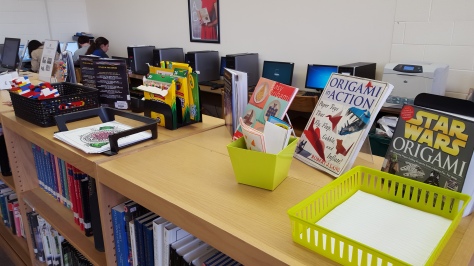

About Sarah and Natasha:
Sarah Strouse: Mrs. Strouse initially received a Bachelor of Arts’ in writing at East Stroudsburg University (ESU) and has since done post-baccalaureate work in Secondary Education and Library Science at ESU and Kutztown University. She taught 9th Grade English at Nazareth Area High School for 8 years before becoming the Library Media Specialist there last fall. Mrs. Strouse is at her happiest from April to October when the New York Yankees are playing and she can wear open-toed shoes. Her favorite books are To Kill a Mockingbird, the Divergent series, and the Throne of Glass series. Perhaps the only thing she loves more than coffee is her family – her 4-year old daughter and husband.
Natasha Lewis: Mrs. Lewis holds a Bachelor of Arts’ degree and a Master’s in Education, both received at Cedar Crest College. Prior to working in the Nazareth Area High School Library, she held several long term substitute positions at local high school and middle schools as well as taught American literature in an asynchronous online setting. She enjoys spending time with her family, working out, knitting/crocheting, drinking A LOT of coffee, and cooking (hence the need for workouts!). Some of her favorite books include the Harry Potter series, The Martian, Ready Player One, Sarah J. Maas’ Throne of Glass series, and the Lunar Chronicles.


